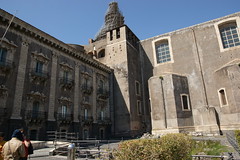
Foto di Allie Caulfield
La Storia
I monaci Benedettini ottennero il permesso di costruire la nuova sede del monastero nella
città di Catania. I lavori iniziarono nel 1558 alla presenza del viceré di Sicilia Juan de
la Cerda. Nel 1669, in seguito ad una devastante eruzione dell'Etna, la lava raggiunse il
centro di Catania e danneggiò le mura del cenobio.
Vi fù in seguito grande fervore dei monaci per la ristrutturazione del monastero, con
l'aggiunta fra l'altro della monumentale fontana marmorea nel chiostro.
In contemporanea fu avviata la costruzione della chiesa di San Nicolò (1687) designed
the Roman architect Giovan Battista Contini.
On 11 January 1693, a terrible earthquake almost completely destroyed Catania conivolgendo
also the magnificent Benedictine monastery, which was reduced to ashes and killing
of most of the monks.
In 1702 began the rebuilding project went under Antonino Amato,
in tune with the ideas of wealth and grandeur of the monks began to build
a second cloister next to the oldest.
structure
You can see the east and south elevations, the work of Antonio Amato, with
splendid baroque carvings, the grand staircase of the neoclassical and the first cloister
with a kiosk in the center of Neo-Gothic style, and yet the second cloister,
dell'antirefettorio circular.
Library Ursino-Recovery
wing of the monastery is occupied by the environments Joined Libraries and Civic Ursino
Recovery: the union of the Public Library and the staff of the Baron Antonio
Ursino Recupero, comes the splendid collection held within the premises of the former Monastery
Benedictines of Catania
Today the library keeps another 200,000 volumes, including the scrolls include
medieval Benedictine monks and a rare Bible of the fourteenth century.
One of the most culturally rich local Vaccarini is the Hall, where the collection of books
Benedictine is organized still in the original arrangement.
The University and the cultural life
The monastery was the seat Benedictine until 1866, then was sold to local and state property in 1977 was officially proclaimed the Faculty of Humanities of Catania. The old monks' cells have been restored and put to classrooms of students.
in the former Monastery Benedictine played every year exhibitions, concerts and
dozens of cultural events.
We organize meetings of astronomy: astrophysics Etna cooperative
Aster have guided the people of Catania to the knowledge of celestial bodies from the terraces of the monastery at the event MonaStelle, sponsored by 'Workshops Cultural Association and the Faculty' of Arts.
are possible guided tours through the history of the enchanting environment of kitchens Vaccarini, the Cloister of the Levant, the archaeological excavations held in the sixteenth and the Garden of Novices.
An important meeting of the FAI, the Italian Environmental Fund, with the theme "FROM THE GARDEN TO THE LANDSCAPE: THE CONTRIBUTION OF THE PROTECTION AND USE THEM TO DO" \u200b\u200bwas established the monastery.
Another great expression of cultural sensitivity to the ethnic market is the Benedictine Monastery, held on 5 March 2010: the last Sunday of each month, a showcase of products and ethnic culture the presence of Mayor Raffaele Stancanelli e dell’assessore alla Famiglia Marco Belluardo. L’iniziativa denominata “Altre culture in città”, ha coinvolto le numerose comunità straniere presenti a Catania. La manifestazione prevista dal progetto “Pari opportunità nella diversità” è stata promossa dall’assessorato alla Famiglia in collaborazione con la facoltà di Lettere e Filosofia dell’Università di Catania, la federazione delle associazioni mauriziane, l’associazione Geetanjali Circle, il coordinamento immigrati, l’associazione di mediatori “impronte culturali”, l’associazione Multikulti, la chiesa ortodossa Romena, la moschea di Catania, il Consorzio il Nodo e l’associazione Tunisia El Amel, coordinated by the Project office and Immigrants Social and Gender Equality of the Municipality.
The various communities have made local handicrafts and traditional foods of
Mauritius, China, Congo, Iran, Tunisia, Palestine, Turkey with the aim of promoting
culture and traditions that distinguish each country. The exhibition curated by the association
Neon products has enhanced the colonnade stands and wrapping cloths
multicolored. Visitors tasted Iranian tea and admired a dance show
anatoliche.
Assieme al centro storico di Catania, fa parte del patrimonio dell'UNESCO.
Viaggiatori Illustri
Patrick Brydone in visita a Catania nel 1770, così scrive a proposito del complesso monumentale
dei Benedettini in una rielaborazione degli appunti del viaggio compiuto realmente dallo
scienziato scozzese in Sicilia e a Malta tra il 15 maggio and July 29, 1770: "He entered the great gate
my surprise grew again, before I had a front
almost equal to that of Versailles, a noble white marble staircase and a magnificent setting its
of a royal residence. I had never heard that the King of Sicily had a palace
in Catania and incidentally could not otherwise explain what I saw. I quickly
return home to inform my discovery as a friend and I found them in the company of
canon recovery that we had come on purpose to take us there and enjoy our
sorpresa ed il nostro stupore. Ci disse poi che il palazzo non era altro che un convento di
grassi monaci benedettini, che volevano assicurarsi a tutti i costi un paradiso almeno in
questo mondo, se non nell’altro".
Charles Didier, scrittore, poeta e viaggiatore francese di origini svizzere nel 1829 rimase
profondamente colpito dal monastero: "L’appartamento dei religiosi è da uomini di mondo.
Il monaco mi ricevette in una camera elegante, quasi ricercata; grandi tende di mussola
yellow and white you were creating a truly gallant. "

0 comments:
Post a Comment